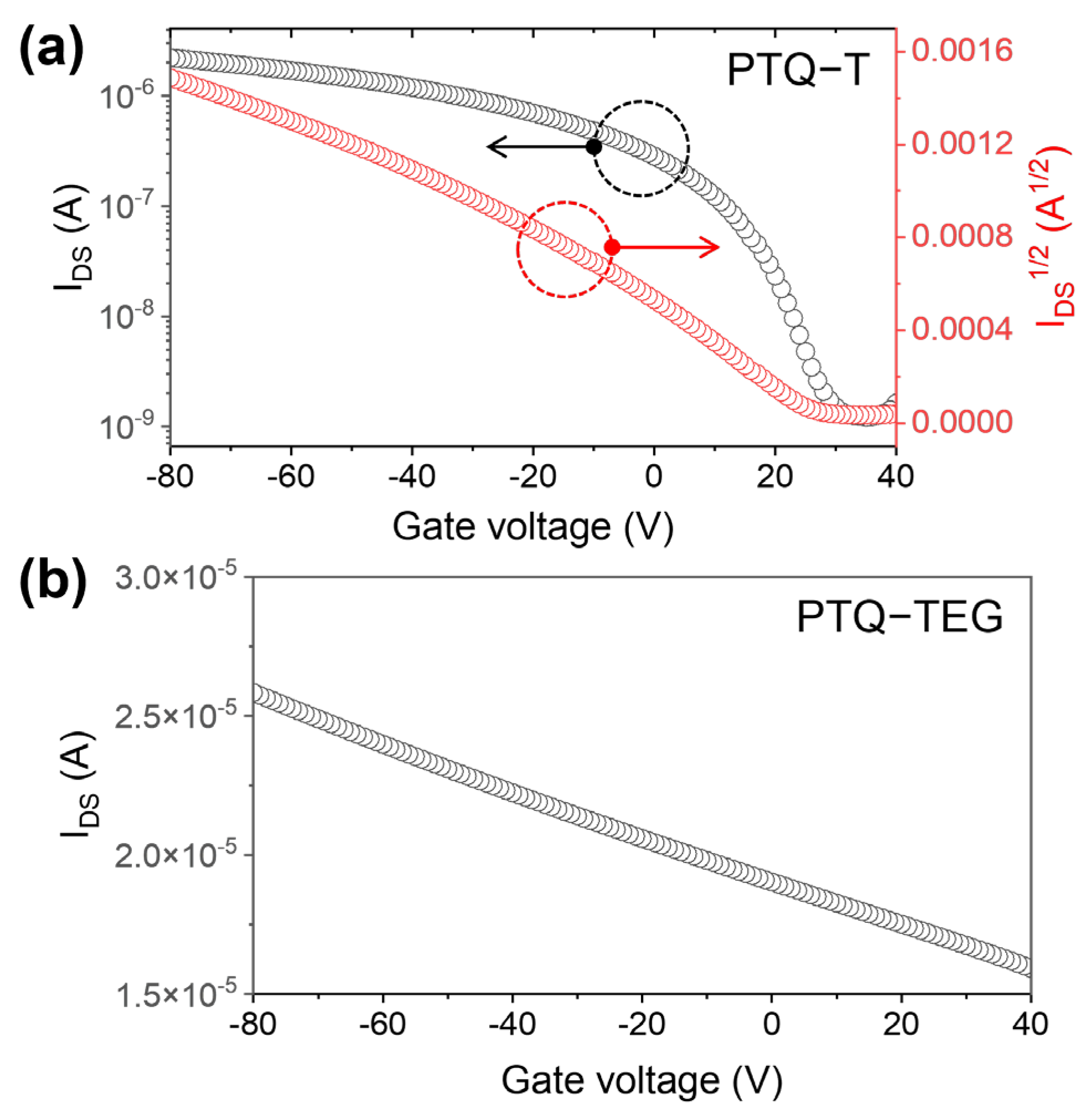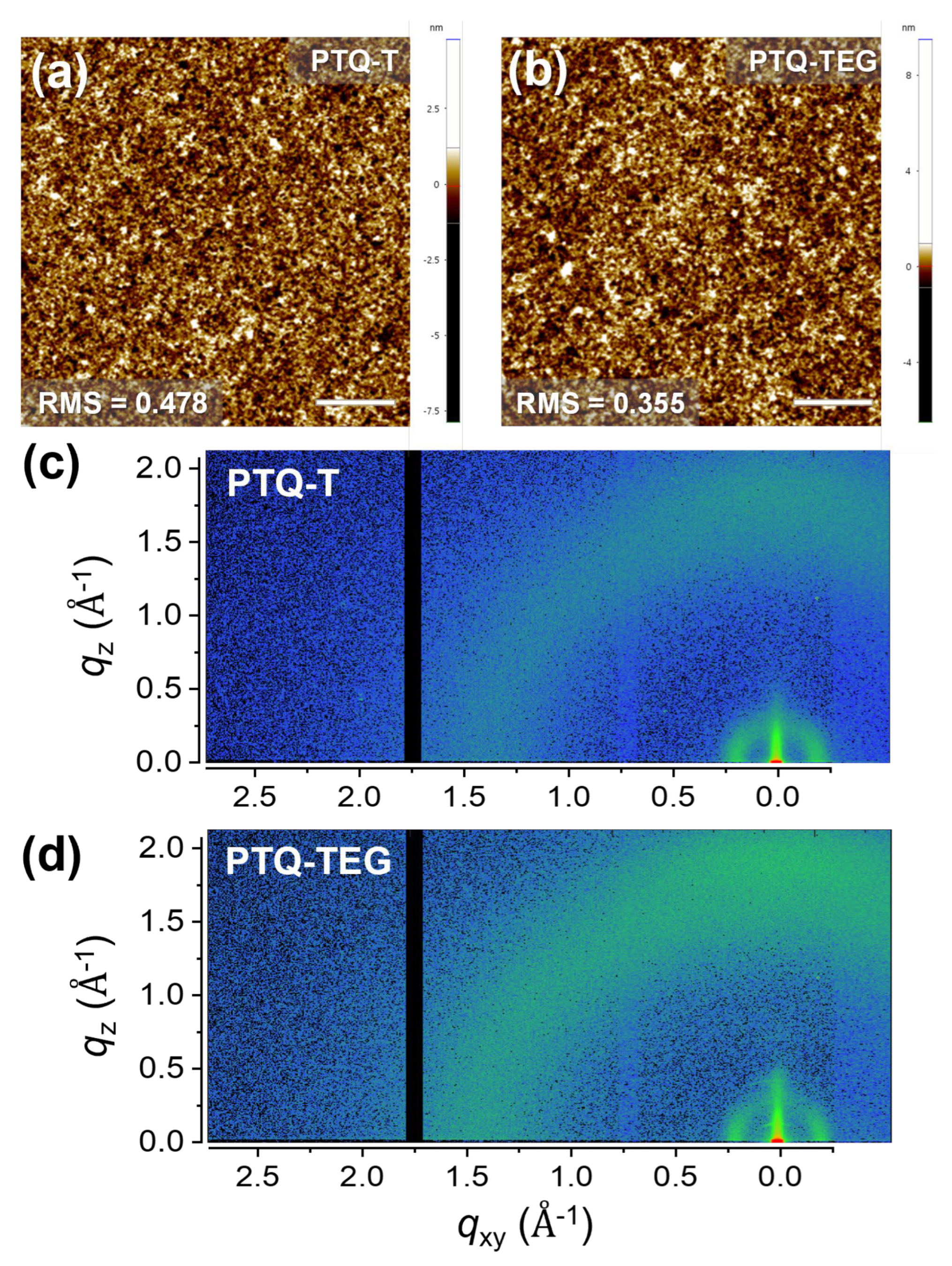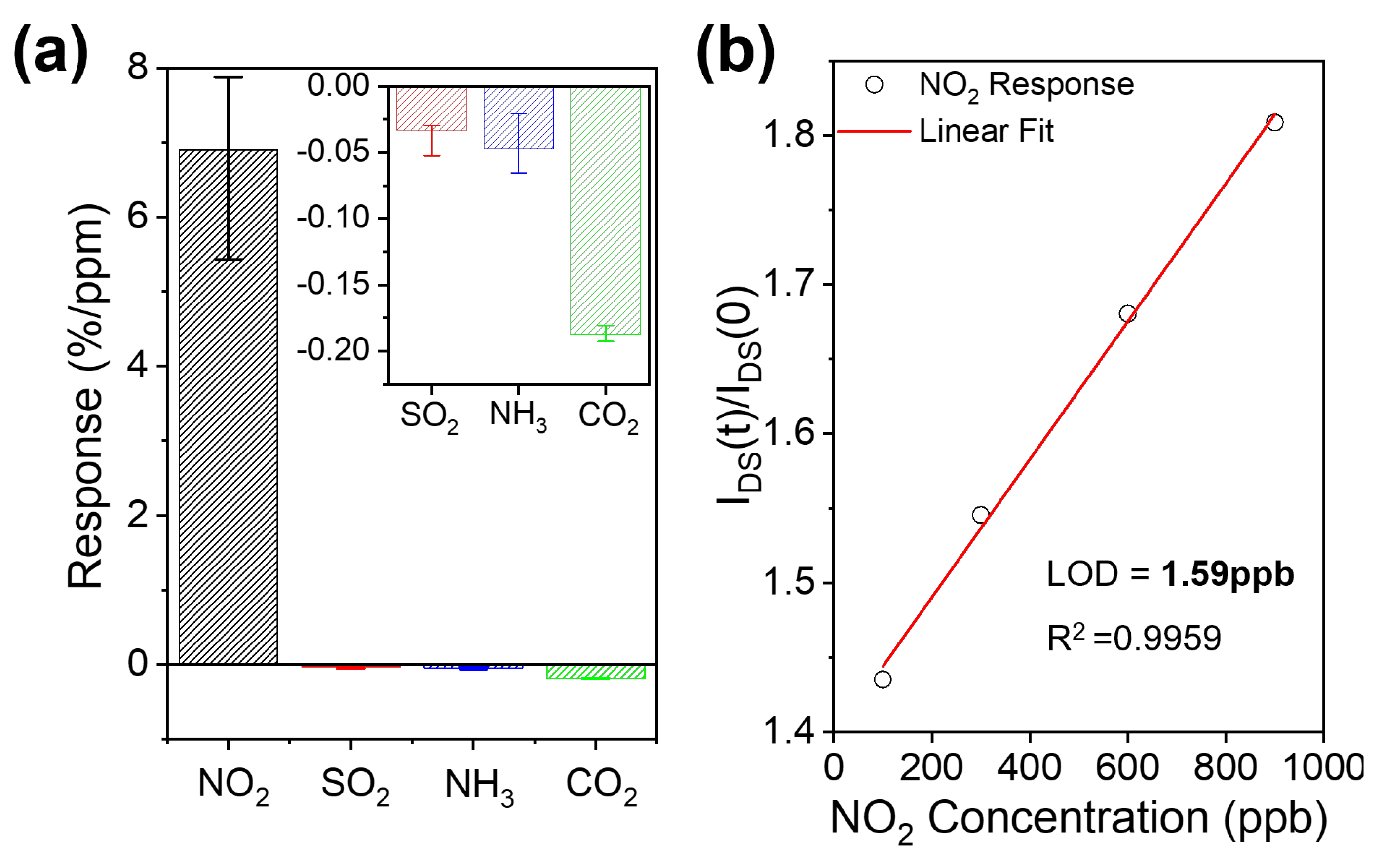Side-Chain-Assisted Transition of Conjugated Polymers from a Semiconductor to Conductor and Comparison of Their NO2 Sensing Characteristics
Abstract
1. Introduction
2. Materials and Methods
2.1. Materials
2.2. PTQ-T and PTQ-TEG
2.3. FET and Gas Sensor Fabrication
2.4. Electrical and Gas Sensing Properties
2.5. Characterization
3. Results and Discussion
4. Conclusions
Supplementary Materials
Author Contributions
Funding
Institutional Review Board Statement
Informed Consent Statement
Data Availability Statement
Acknowledgments
Conflicts of Interest
References
- Liang, S.; Jiang, X.; Xiao, C.; Li, C.; Chen, Q.; Li, W. Double-Cable Conjugated Polymers with Pendant Rylene Diimides for Single-Component Organic Solar Cells. Acc. Chem. Res. 2021, 54, 2227–2237. [Google Scholar] [CrossRef] [PubMed]
- Zhu, L.; Zhang, M.; Zhong, W.; Leng, S.; Zhou, G.; Zou, Y.; Su, X.; Ding, H.; Gu, P.; Liu, F.; et al. Progress and prospects of the morphology of non-fullerene acceptor based high-efficiency organic solar cells. Energy Environ. Sci. 2021, 14, 4341–4357. [Google Scholar] [CrossRef]
- Yao, Z.-F.; Wang, J.-Y.; Pei, J. High-performance polymer field-effect transistors: From the perspective of multi-level microstructures. Chem. Sci. 2021, 12, 1193–1205. [Google Scholar] [CrossRef] [PubMed]
- Yang, Y.; Hong, Y.; Wang, X. Utilizing the Diffusion of Fluorinated Polymers to Modify the Semiconductor/Dielectric Interface in Solution-Processed Conjugated Polymer Field-Effect Transistors. ACS Appl. Mater. Interfaces 2021, 13, 8682–8691. [Google Scholar] [CrossRef] [PubMed]
- Han, J.M.; Yoon, S.E.; Jung, K.H.; Bae, O.; Kim, D.; Kim, U.; Seo, H.; Kim, F.S.; Kim, K.C.; Kim, J.H.; et al. Dopant-dependent thermoelectric performance of indoloindole-selenophene based conjugated polymer. Chem. Eng. J. 2022, 431, 133779. [Google Scholar] [CrossRef]
- Fontana, M.T.; Stanfield, D.A.; Scholes, D.T.; Winchell, K.J.; Tolbert, S.H.; Schwartz, B.J. Evaporation vs. Solution Sequential Doping of Conjugated Polymers: F4TCNQ Doping of Micrometer-Thick P3HT Films for Thermoelectrics. J. Phys. Chem. C 2019, 123, 22711–22724. [Google Scholar] [CrossRef]
- Jeon, S.; Lee, J.H.; Park, J.I.; Jo, B.; Whang, D.R.; Ahn, T.K.; Park, H.J.; Kim, S.D.; Lee, W.H.; Kim, B.-G. Manipulation of Chain Conformation for Optimum Charge-Transport Pathways in Conjugated Polymers. ACS Appl. Mater. Interfaces 2017, 9, 22757–22763. [Google Scholar] [CrossRef]
- Fratini, S.; Nikolka, M.; Salleo, A.; Schweicher, G.; Sirringhaus, H. Charge transport in high-mobility conjugated polymers and molecular semiconductors. Nat. Mater. 2020, 19, 491–502. [Google Scholar] [CrossRef]
- Park, K.S.; Kwok, J.J.; Dilmurat, R.; Qu, G.; Kafle, P.; Luo, X.; Jung, S.-H.; Oliver, Y.; Lee, J.-K.; Mei, J.; et al. Tuning conformation, assembly, and charge transport properties of conjugated polymers by printing flow. Sci. Adv. 2019, 5, eaaw7757. [Google Scholar] [CrossRef]
- Méndez, H.; Heimel, G.; Opitz, A.; Sauer, K.; Barkowski, P.; Oehzelt, M.; Soeda, J.; Okamoto, T.; Takeya, J.; Arlin, J.-B.; et al. Doping of Organic Semiconductors: Impact of Dopant Strength and Electronic Coupling. Angew. Chem. Int. Ed. 2013, 125, 7905–7909. [Google Scholar] [CrossRef]
- Yoon, S.E.; Park, J.; Kwon, J.E.; Lee, S.Y.; Han, J.M.; Go, C.Y.; Choi, S.; Kim, K.C.; Seo, H.; Kim, J.H.; et al. Improvement of Electrical Conductivity in Conjugated Polymers through Cascade Doping with Small-Molecular Dopants. Adv. Mater. 2020, 32, 2005129. [Google Scholar] [CrossRef]
- Park, J.; Yoon, S.E.; Lee, J.; Whang, D.R.; Lee, S.Y.; Shin, S.J.; Han, J.M.; Seo, H.; Park, H.J.; Kim, J.H.; et al. Unraveling doping capability of conjugated polymers for strategic manipulation of electric dipole layer toward efficient charge collection in perovskite solar cells. Adv. Funct. Mater. 2020, 30, 2001560. [Google Scholar] [CrossRef]
- Yoon, S.E.; Kang, Y.; Jeon, G.G.; Jeon, D.; Lee, S.Y.; Ko, S.-J.; Kim, T.; Seo, H.; Kim, B.-G.; Kim, J.H. Exploring wholly doped conjugated polymer films based on hybrid doping: Strategic approach for optimizing electrical conductivity and related thermoelectric properties. Adv. Funct. Mater. 2020, 30, 2004598. [Google Scholar] [CrossRef]
- Yoon, S.E.; Kang, Y.; Noh, S.Y.; Park, J.; Lee, S.Y.; Park, J.; Lee, D.W.; Whang, D.R.; Kim, T.; Kim, G.-H.; et al. High efficiency doping of conjugated polymer for investigation of intercorrelation of thermoelectric effects with electrical and morphological properties. ACS Appl. Mater. Interfaces 2020, 12, 1151–1158. [Google Scholar] [CrossRef]
- Cheon, H.J.; Li, X.; Jeong, Y.J.; Sung, M.J.; Li, Z.; Jeon, I.; Tang, X.; Girma, H.G.; Kong, H.; Kwon, S.-K.; et al. A novel design of donor–acceptor polymer semiconductors for printed electronics: Application to transistors and gas sensors. J. Mater. Chem. C 2020, 8, 8410–8419. [Google Scholar] [CrossRef]
- Cheon, H.J.; Shin, S.Y.; Tran, V.V.; Park, B.; Yoon, H.; Chang, M. Preparation of conjugated polymer/reduced graphene oxide nanocomposites for high-performance volatile organic compound sensors. Chem. Eng. J. 2021, 425, 131424. [Google Scholar] [CrossRef]
- Kwon, E.H.; An, H.; Park, M.B.; Kim, M.; Park, Y.D. Conjugated polymer–zeolite hybrids for robust gas sensors: Effect of zeolite surface area on NO2 sensing ability. Chem. Eng. J. 2021, 420, 129588. [Google Scholar] [CrossRef]
- Kang, Y.; Kwak, D.H.; Kwon, J.E.; Kim, B.-G.; Lee, H. NO2-Affinitive Conjugated Polymer for Selective Sub-Parts-Per-Billion NO2 Detection in a Field-Effect Transistor Sensor. ACS Appl. Mater. Interfaces 2021, 13, 31910–31918. [Google Scholar] [CrossRef]
- Lin, Y.-C.; Lu, Y.-J.; Tsao, C.-S.; Saeki, A.; Li, J.-X.; Chen, C.-H.; Wang, H.-C.; Chen, H.-C.; Meng, D.; Wu, K.-H.; et al. Enhancing photovoltaic performance by tuning the domain sizes of a small-molecule acceptor by side-chain-engineered polymer donors. J. Mater. Chem. A 2019, 7, 3072. [Google Scholar] [CrossRef]
- Otep, S.; Lin, Y.-C.; Matsumoto, H.; Mori, T.; Wei, K.-H.; Michinobu, T. Diketopyrrolopyrrole–thiophene–methoxythiophene based random copolymers for organic field effect transistor applications. Org. Electron. 2020, 87, 105986. [Google Scholar] [CrossRef]
- Jia, S.; Qi, S.; Xing, Z.; Li, S.; Wang, Q.; Chen, Z. Effects of Different Lengths of Oligo (Ethylene Glycol) Side Chains on the Electrochromic and Photovoltaic Properties of Benzothiadiazole-Based Donor-Acceptor Conjugated Polymers. Molecules 2023, 28, 2056. [Google Scholar] [CrossRef]
- Lin, K.; Wu, C.; Zhang, G.; Wu, Z.; Tang, S.; Lin, Y.; Li, X.; Jiang, Y.; Lin, H.; Wang, Y.; et al. Toward High-Performance Electrochromic Conjugated Polymers: Influence of Local Chemical Environment and Side-Chain Engineering. Molecules 2022, 27, 8424. [Google Scholar] [CrossRef] [PubMed]
- Shi, Y.; Li, J.; Sun, H.; Li, Y.; Wang, Y.; Wu, Z.; Jeong, S.Y.; Woo, H.Y.; Fabiano, S.; Guo, X. Thiazole Imide-Based All-Acceptor Homopolymer with Branched Ethylene Glycol Side Chains for Organic Thermoelectrics. Angew. Chem. Int. Ed. 2022, 61, e202214192. [Google Scholar] [CrossRef] [PubMed]
- Saber, A.F.; Elewa, A.M.; Chou, H.-H.; EL-Mahdy, A.F.M. Donor to Acceptor Charge Transfer in Carbazole-based Conjugated Microporous Polymers for Enhanced Visible Light-Driven Photocatalytic Water Splitting. ChemCatChem 2023, 15, e202201287. [Google Scholar] [CrossRef]
- Barman, S.; Singh, A.; Rahimi, F.A.; Maji, T.K. Metal-Free Catalysis: A Redox-Active Donor-Acceptor Conjugated Microporous Polymer for Selective Visible-Light-Driven CO2 Reduction to CH4. J. Am. Chem. Soc. 2021, 143, 16284. [Google Scholar] [CrossRef] [PubMed]
- Saber, A.F.; Elewa, A.M.; Chou, H.-H.; EL-Mahdy, A.F.M. Donor-acceptor carbazole-based conjugated microporous polymers as photocatalysts for visible-light-driven H2 and O2 evolution from water splitting. Appl. Catal. B Environ. 2022, 316, 121624. [Google Scholar] [CrossRef]
- Chang, C.-L.; Elewa, A.M.; Wang, J.H.; Chou, H.-H.; EL-Mahdy, A.F.M. Donor-acceptor conjugated microporous polymers based on Thiazolo[5,4-d]thiazole building block for high-performance visible-light-induced H2 production. Microporous Mesoporous Mater. 2022, 345, 112258. [Google Scholar] [CrossRef]
- Xie, P.; Han, C.; Xiang, S.; Jin, S.; Ge, M.; Zhang, C.; Jiang, J.-X. Toward high-performance dibenzo[g,p]chrysene-based conjugated polymer photocatalysts for photocatalytic hydrogen production through donor-acceptor-acceptor structure design. Chem. Eng. J. 2023, 459, 141553. [Google Scholar] [CrossRef]
- Gao, L.; Liu, C.; Peng, Y.; Deng, J.; Hou, S.; Cheng, Y.; Huang, W.; Yu, J. Ultrasensitive flexible NO2 gas sensors via multilayer porous polymer film. Sens. Actuators B Chem. 2022, 368, 132113. [Google Scholar] [CrossRef]
- Luo, H.; Kaneti, Y.V.; Ai, Y.; Wu, Y.; Wei, F.; Fu, J.; Cheng, J.; Jing, C.; Yuliarto, B.; Eguchi, M.; et al. Nanoarchitectured Porous Conducting Polymers: From Controlled Synthesis to Advanced Applications. Adv. Mater. 2021, 33, 2007318. [Google Scholar] [CrossRef]
- Park, H.; Kim, D.-H.; Ma, B.S.; Shin, E.; Kim, Y.; Kim, T.-S.; Kim, F.S.; Kim, I.-D.; Kim, B.J. High-Performance, Flexible NO2 Chemiresistors Achieved by Design of Imine-Incorporated n-Type Conjugated Polymers. Adv. Sci. 2022, 9, 2200270. [Google Scholar] [CrossRef]
- Chen, Z.; Yu, C.; Bai, W.; Ye, W.; Wang, J.; Wei, J.; Wang, Y.; He, J.; Lu, J. Surface functionalization of ion-in-conjugation polymer sensors for humidity-independent gas detection at room temperature. Sens. Actuators B Chem. 2022, 372, 132654. [Google Scholar] [CrossRef]
- Ngai, J.H.L.; Gao, X.; Kumar, P.; Polena, J.; Li, Y. A Highly Stable Diketopyrrolopyrrole (DPP) Polymer for Chemiresistive Sensors. Adv. Electron. Mater. 2021, 7, 2000935. [Google Scholar] [CrossRef]
- Chae, H.; Han, J.M.; Ahn, Y.; Kwon, J.E.; Lee, W.H.; Kim, B.-G. NO2-Affinitive Amorphous Conjugated Polymer for Field-Effect Transistor Sensor toward Improved NO2 Detection Capability. Adv. Mater. Technol. 2021, 6, 2100580. [Google Scholar] [CrossRef]
- Yang, Y.; Liu, Z.; Zhang, G.; Zhang, X.; Zhang, D. The Effects of Side Chains on the Charge Mobilities and Functionalities of Semiconducting Conjugated Polymers beyond Solubilities. Adv. Mater. 2019, 31, 1903104. [Google Scholar] [CrossRef]
- Lu, C.-F.; Liao, S.-F.; Chen, I.-F.; Chen, C.-T.; Chao, C.-Y.; Su, W.-F. Detecting Minute Chemical Vapors via Chemical Interactions between Analyte and Fluorinated Thiophene-Isoindigo Conjugated Polymer Transistor. ACS Appl. Electron. Mater. 2019, 1, 1873–1880. [Google Scholar] [CrossRef]
- Yu, C.; Lin, H.-Z.; Zhou, J.; Cheng, X.-F.; He, J.-H.; Li, H.; Xu, Q.-F.; Li, N.-J.; Chen, D.-Y.; Lu, J.-M. An ion-inconjugation polymer enables the detection of NO2 with parts-per-trillion sensitivity and ultrahigh selectivity. J. Mater. Chem. A 2020, 8, 1052–1058. [Google Scholar] [CrossRef]
- Perzon, E.; Zhang, F.; Andersson, M.; Mammo, W.; Inganäs, O.; Andersson, M.R. A Conjugated Polymer for Near Infrared Optoelectronic Applications. Adv. Mater. 2007, 19, 3308–3311. [Google Scholar] [CrossRef]
- Zhao, X.; Cai, H.; Deng, Y.; Jiang, Y.; Wang, Z.; Shi, Y.; Han, Y.; Geng, Y. Low-Band gap Conjugated Polymers with Strong Absorption in the Second Near-Infrared Region Based on Diketopyrrolopyrrole-Containing Quinoidal Units. Macromolecules 2021, 54, 3498–3506. [Google Scholar] [CrossRef]
- Chen, H.; Cai, G.; Guo, A.; Zhao, Z.; Kuang, J.; Zheng, L.; Zhao, L.; Chen, J.; Guo, Y.; Liu, Y. Low Band Gap Donor–Acceptor Conjugated Polymers with Indanone-Condensed Thiadiazolo[3,4-g]quinoxaline Acceptors. Macromolecules 2019, 52, 6149–6159. [Google Scholar] [CrossRef]
- Kim, B.-G.; Zhen, C.-G.; Jeong, E.J.; Kieffer, J.; Kim, J. Organic dye design tools for efficient photocurrent generation in dye-sensitized solar cells: Exciton binding energy and electron Acceptors. Adv. Funct. Mater. 2012, 22, 1606–1612. [Google Scholar] [CrossRef]
- Kang, Y.; Eun, H.J.; Kye, H.; Kim, D.; Heo, J.; Kim, J.H.; Kim, B.-G. Side-chain engineering of conjugated polymers toward highly efficient near-infrared organic photo-detectors via morphology and dark current management. J. Mater. Chem. C 2020, 8, 7765. [Google Scholar] [CrossRef]
- Hou, Y.; Long, G.; Sui, D.; Cai, Y.; Wan, X.; Yu, A.; Chen, Y. Different donor–acceptor structures of dithiafulvalene-fused semiconducting polymers with different band gaps. Chem. Commun. 2011, 47, 10401. [Google Scholar] [CrossRef] [PubMed]
- Jiao, Z.; Jiang, T.; Zhou, Z.; Qin, C.; Long, J.; Liu, Y.; Jiang, Y. Identification of a bridge-specific intramolecular exciton dissociation pathway in donor–π–acceptor alternating conjugated polymers. Nanoscale Res. Lett. 2021, 16, 51. [Google Scholar] [CrossRef]
- Ahmed, L.R.; Gilmanova, L.; Pan, C.-T.; Kaskel, S.; EL-Mahdy, A.F.M. Hollow Spherical Covalent Organic Frameworks from Nonplanar or Planar Monomers for the Fluorescence Detection of Telomere DNA: Role of the 2-(2-Azidoethoxy)ethoxy Group. ACS Appl. Polym. Mater. 2022, 4, 9132. [Google Scholar] [CrossRef]
- Lee, S.W.; Hussain, W.; Lee, J.; Whang, D.R.; Jeong, W.H.; Choi, H.; Chang, D.W. Effect of Chlorine Substituents on Photovoltaic Properties of Monocyanated Quinoxaline-Based Polymers. ACS Appl. Mater. Interfaces 2023, 15, 5547–5555. [Google Scholar] [CrossRef]
- Sagita, C.P.; Yoon, J.W.; Keong, M.; Lee, S.W.; Bae, H.; Whang, D.R.; Choi, H.; Ko, S.-J.; Chang, D.W. Improved Photovoltaic Performance of Quinxoalne-Based Polymers by Systematic Modulation of Electron-Withdrawing Substituents. J. Mater. Chem. C 2022, 10, 10338–10346. [Google Scholar] [CrossRef]
- Schwarze, M.; Gaul, C.; Scholz, R.; Bussolotti, F.; Hofacker, A.; Schellhammer, K.S.; Nell, B.; Naab, B.D.; Bao, Z.; Spoltore, D.; et al. Molecular parameters responsible for thermally activated transport in doped organic semiconductors. Nat. Mater. 2019, 18, 242–248. [Google Scholar] [CrossRef]
- Deng, J.; Zheng, L.; Ding, C.; Guo, Y.; Xie, Y.; Wang, J.; Ke, Y.; Li, M.; Li, L.; Janssen, R.A.J. Determinant Role of Solution-State Supramolecular Assembly in Molecular Orientation of Conjugated Polymer Films. Adv. Funct. Mater. 2023, 33, 2209195. [Google Scholar] [CrossRef]
- Moro, S.; Siemons, N.; Drury, O.; Warr, D.A.; Moriarty, T.A.; Perdigão, L.M.A.; Pearce, D.; Moser, M.; Hallani, R.K.; Parker, J.; et al. The Effect of Glycol Side Chains on the Assembly and Microstructure of Conjugated Polymers. ACS Nano 2022, 16, 21303–21314. [Google Scholar] [CrossRef]
- Mahmood, J.; Park, J.; Shin, D.; Choi, H.-J.; Seo, J.-M.; Yoo, J.-W.; Baek, J.-B. Organic Ferromagnetism: Trapping Spins in the Glassy State of an Organic Network Structure. Chem 2018, 4, 2357–2369. [Google Scholar] [CrossRef]
- Chen, Z.X.; Li, Y.; Huang, F. Persistent and Stable Organic Radicals: Design, Synthesis, and Applications. Chem 2021, 7, 288–332. [Google Scholar] [CrossRef]
- Sharma, V.; Puthumana, U.; Karak, P.; Koner, A.L. Visible-Light-Triggered Generation of Ultrastable Radical Anion from Nitro-substituted Perylenediimides. J. Org. Chem. 2018, 83, 11458–11462. [Google Scholar] [CrossRef] [PubMed]







Disclaimer/Publisher’s Note: The statements, opinions and data contained in all publications are solely those of the individual author(s) and contributor(s) and not of MDPI and/or the editor(s). MDPI and/or the editor(s) disclaim responsibility for any injury to people or property resulting from any ideas, methods, instructions or products referred to in the content. |
© 2023 by the authors. Licensee MDPI, Basel, Switzerland. This article is an open access article distributed under the terms and conditions of the Creative Commons Attribution (CC BY) license (https://creativecommons.org/licenses/by/4.0/).
Share and Cite
Ahn, Y.; Hwang, S.; Kye, H.; Kim, M.S.; Lee, W.H.; Kim, B.-G. Side-Chain-Assisted Transition of Conjugated Polymers from a Semiconductor to Conductor and Comparison of Their NO2 Sensing Characteristics. Materials 2023, 16, 2877. https://doi.org/10.3390/ma16072877
Ahn Y, Hwang S, Kye H, Kim MS, Lee WH, Kim B-G. Side-Chain-Assisted Transition of Conjugated Polymers from a Semiconductor to Conductor and Comparison of Their NO2 Sensing Characteristics. Materials. 2023; 16(7):2877. https://doi.org/10.3390/ma16072877
Chicago/Turabian StyleAhn, Yejin, Sooji Hwang, Hyojin Kye, Min Seon Kim, Wi Hyoung Lee, and Bong-Gi Kim. 2023. "Side-Chain-Assisted Transition of Conjugated Polymers from a Semiconductor to Conductor and Comparison of Their NO2 Sensing Characteristics" Materials 16, no. 7: 2877. https://doi.org/10.3390/ma16072877
APA StyleAhn, Y., Hwang, S., Kye, H., Kim, M. S., Lee, W. H., & Kim, B.-G. (2023). Side-Chain-Assisted Transition of Conjugated Polymers from a Semiconductor to Conductor and Comparison of Their NO2 Sensing Characteristics. Materials, 16(7), 2877. https://doi.org/10.3390/ma16072877






